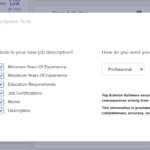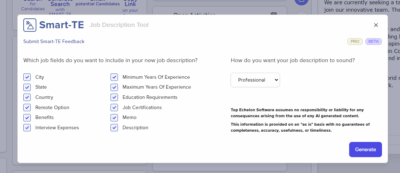In the recruiting profession, the ability to streamline and accelerate the hiring process is critical for agency recruiters and search consultants. One of the most powerful tools available in recruiting agency software is the Pipeline feature.
This feature helps manage candidates through the various stages of the recruitment process, ensuring that no talent slips through the cracks and that placements are made efficiently and effectively. This comprehensive guide will explore how to master the Pipeline feature in your recruiting software to accelerate the recruiting and hiring process and ultimately make more placements.
Understanding the Pipeline Feature
What is a Recruiting Pipeline?
A recruiting pipeline is a visual representation of the candidate journey from initial contact to final placement. It allows recruiters to track where each candidate is in the hiring process, identify bottlenecks, and ensure timely follow-ups. The Pipeline feature in recruiting software provides a structured approach to managing candidates and optimizing the recruitment workflow.
Benefits of Using the Pipeline Feature
- Organized Workflow: Keeps the recruitment process organized and streamlined, reducing the risk of losing track of candidates.
- Increased Efficiency: Accelerates the hiring process by providing a clear overview of each candidate’s status and next steps.
- Better Candidate Experience: Ensures timely communication and updates, enhancing the candidate experience.
- Data-Driven Decisions: Provides valuable insights and analytics to improve recruitment strategies and decision-making.
Setting Up Your Recruiting Pipeline
Customizing Pipeline Stages
The first step to mastering the Pipeline feature is customizing the stages to match your recruitment process. Each stage should represent a significant step in the candidate journey, from initial contact to final placement.
Common Pipeline Stages:
- Sourcing: Identifying and attracting potential candidates.
- Application Received: Candidates submit their applications.
- Screening: Initial review of applications and resumes.
- Interview Scheduling: Coordinating and scheduling interviews.
- Interviews: Conducting phone, video, or in-person interviews.
- Assessment: Evaluating candidates through tests, assessments, or assignments.
- Reference Checks: Conducting background and reference checks.
- Offer Extended: Extending job offers to selected candidates.
- Offer Accepted: Candidates accept the job offer.
- Placement: Finalizing the placement and onboarding process.
Configuring Pipeline Settings
Most recruiting software allows for customization of the pipeline settings to fit your specific needs. Configure settings such as notifications, automated actions, and integration with other tools to enhance the pipeline’s functionality.
Key Configuration Settings:
- Notifications: Set up email or in-app notifications to alert you when a candidate moves to a new stage or requires action.
- Automated Actions: Automate routine tasks such as sending follow-up emails or scheduling interviews.
- Integration: Integrate your pipeline with other tools such as email, calendar, and assessment platforms for seamless workflow.
Defining Roles and Responsibilities
Clearly define the roles and responsibilities of each team member involved in the recruitment process. Assign specific tasks and stages to recruiters, hiring managers, and support staff to ensure a smooth and efficient workflow.
Key Roles and Responsibilities:
- Recruiters: Responsible for sourcing, screening, and initial interviews.
- Hiring Managers: Conduct in-depth interviews and make final hiring decisions.
- Support Staff: Handle administrative tasks such as scheduling and coordinating interviews.
Optimizing the Recruiting Pipeline
Streamlining Candidate Sourcing
Efficient candidate sourcing is the foundation of a successful recruiting pipeline. Use various sourcing channels and tools to attract top talent and ensure a steady flow of candidates into your pipeline.
Sourcing Strategies:
- Job Boards: Post job openings on popular job boards to reach a wide audience.
- Social Media: Use social media platforms such as LinkedIn, Facebook, and Twitter to promote job openings and engage with potential candidates.
- Employee Referrals: Encourage current employees to refer qualified candidates.
- Recruitment Marketing: Use targeted marketing campaigns to attract candidates with specific skills and experience.
Effective Candidate Screening
Screening candidates efficiently is crucial for maintaining a smooth pipeline. Use automated tools and structured processes to quickly identify the most qualified candidates.
Screening Techniques:
- Automated Resume Parsing: Use software to automatically parse and analyze resumes, identifying key qualifications and skills.
- Pre-Screening Questionnaires: Implement pre-screening questionnaires to filter out unqualified candidates early in the process.
- Phone Screens: Conduct brief phone screens to assess candidates’ basic qualifications and fit.
Efficient Interview Scheduling
Interview scheduling can be a significant bottleneck in the recruitment process. Use automated scheduling tools to streamline this stage and reduce delays.
Scheduling Tips:
- Automated Scheduling Tools: Use tools that allow candidates to select interview times based on availability, reducing back-and-forth communication.
- Calendar Integration: Integrate scheduling tools with your calendar to ensure availability and avoid conflicts.
- Reminders: Set up automated reminders for both candidates and interviewers to minimize no-shows and ensure punctuality.
Conducting Effective Interviews
Effective interviews are key to selecting the right candidates. Use structured interview processes and tools to ensure consistency and fairness.
Interview Best Practices:
- Structured Interviews: Use a standardized set of questions for each candidate to ensure consistency and comparability.
- Interview Panels: Involve multiple interviewers to get diverse perspectives and reduce bias.
- Candidate Evaluation Forms: Use evaluation forms to systematically assess candidates’ performance and fit.
Streamlining Assessments and Reference Checks
Assessments and reference checks are critical for verifying candidates’ qualifications and fit. Use automated tools and standardized processes to streamline these stages.
Assessment Tips:
- Online Assessments: Use online assessment platforms to evaluate candidates’ skills and competencies.
- Standardized Tests: Implement standardized tests for technical skills, cognitive abilities, and personality traits.
- Reference Check Tools: Use automated reference check tools to collect and verify references quickly and efficiently.
Efficient Offer Management
Extending and managing job offers efficiently is crucial for closing candidates and making placements. Use tools and strategies to streamline this stage and ensure a smooth process.
Offer Management Tips:
- Automated Offer Letters: Use software to generate and send offer letters automatically.
- Negotiation Support: Provide tools and resources to support offer negotiations, such as salary benchmarks and benefits information.
- Acceptance Tracking: Track offer acceptance rates and follow up with candidates to ensure timely responses.
Enhancing Candidate Communication
Effective communication is key to maintaining candidate engagement and ensuring a positive experience. Use your pipeline feature to manage and streamline communication throughout the recruitment process.
Communication Strategies:
- Regular Updates: Keep candidates informed about their status and next steps with regular updates.
- Personalized Messages: Personalize communication to make candidates feel valued and respected.
- Timely Responses: Respond to candidate inquiries promptly to maintain engagement and trust.
Leveraging Analytics and Reporting
Data and analytics can provide valuable insights into your recruitment process and help you identify areas for improvement. Use the reporting features of your pipeline to track key metrics and make data-driven decisions.
Key Metrics to Track:
- Time-to-Fill: Measure the average time it takes to fill a position from initial contact to placement.
- Conversion Rates: Track conversion rates at each stage of the pipeline to identify bottlenecks and areas for improvement.
- Candidate Drop-Off Rates: Monitor candidate drop-off rates to identify stages where candidates are most likely to disengage.
- Source Effectiveness: Analyze the effectiveness of different sourcing channels to optimize your recruitment marketing efforts.
Case Studies: Success Stories of Mastering the Pipeline Feature
Case Study 1: A Tech Recruitment Firm’s Pipeline Optimization
A tech recruitment firm faced challenges with managing a high volume of candidates and maintaining a smooth workflow. By optimizing their pipeline feature, they were able to significantly improve their recruitment process.
Strategies Implemented:
- Customized Pipeline Stages: The firm customized their pipeline stages to match their specific recruitment process, ensuring clarity and organization.
- Automated Actions: They set up automated actions for routine tasks such as sending follow-up emails and scheduling interviews.
- Data-Driven Decisions: The firm used analytics to track key metrics and make data-driven decisions to improve their process.
Results:
- Increased Efficiency: The optimized pipeline led to a 30% reduction in time-to-fill for open positions.
- Higher Candidate Engagement: Improved communication and timely updates increased candidate engagement and satisfaction.
- More Placements: The firm achieved a 25% increase in successful placements, leading to higher revenue and client satisfaction.
Case Study 2: A Healthcare Recruitment Agency’s Pipeline Transformation
A healthcare recruitment agency struggled with candidate drop-off rates and inefficient processes. By transforming their pipeline feature, they were able to achieve significant improvements.
Strategies Implemented:
- Streamlined Screening: The agency implemented automated resume parsing and pre-screening questionnaires to quickly identify qualified candidates.
- Efficient Scheduling: They used automated scheduling tools to streamline the interview process and reduce delays.
- Enhanced Communication: The agency focused on personalized and timely communication to maintain candidate engagement.
Results:
- Reduced Drop-Off Rates: Candidate drop-off rates decreased by 40%, with more candidates staying engaged throughout the process.
- Faster Placements: The time-to-fill for open positions was reduced by 35%, allowing the agency to make more placements in less time.
- Improved Candidate Experience: Candidates reported a positive experience, leading to higher satisfaction and more referrals.
Practical Tips for Mastering the Pipeline Feature
1. Regularly Review and Update Pipeline Stages
Regularly review and update your pipeline stages to ensure they align with your recruitment process and business goals. Make adjustments as needed to improve efficiency and effectiveness.
Review Tips:
- Conduct Regular Audits: Perform regular audits of your pipeline stages to identify areas for improvement.
- Seek Feedback: Gather feedback from recruiters and hiring managers to understand their experiences and challenges.
- Stay Agile: Be willing to make changes and adjustments based on feedback and data insights.
2. Train Your Team
Provide training and resources to ensure that your team is proficient in using the pipeline feature. Regular training can help improve efficiency and effectiveness.
Training Tips:
- Conduct Workshops: Organize workshops and training sessions to educate your team on best practices and new features.
- Provide Resources: Offer resources such as user manuals, video tutorials, and cheat sheets to support ongoing learning.
- Encourage Collaboration: Foster a culture of collaboration and knowledge-sharing among your team members.
3. Leverage Automation
Take advantage of automation features to streamline routine tasks and reduce manual effort. Automation can significantly improve efficiency and free up time for more strategic activities.
Automation Tips:
- Automate Routine Tasks: Use automation for tasks such as sending follow-up emails, scheduling interviews, and updating candidate statuses.
- Set Up Workflows: Create automated workflows to ensure that tasks are completed consistently and on time.
- Monitor Performance: Regularly monitor the performance of automated tasks to ensure they are functioning as expected.
4. Foster Collaboration and Communication
Encourage collaboration and communication among your team members to ensure a smooth and efficient recruitment process. Use tools and strategies to facilitate teamwork and information-sharing.
Collaboration Tips:
- Shared Tools: Use shared tools such as calendars, task management platforms, and communication apps to coordinate efforts.
- Regular Meetings: Schedule regular team meetings to discuss progress, challenges, and solutions.
- Open Communication: Foster an environment of open communication where team members feel comfortable sharing ideas and feedback.
5. Continuously Monitor and Improve
Continuously monitor the performance of your recruiting pipeline and make improvements based on data insights and feedback. Regularly assess your process and make adjustments as needed.
Improvement Tips:
- Track Metrics: Regularly track key metrics such as time-to-fill, conversion rates, and candidate satisfaction.
- Analyze Data: Analyze data to identify trends, bottlenecks, and areas for improvement.
- Implement Changes: Implement changes and improvements based on data insights and feedback.
- Evaluate Impact: Continuously evaluate the impact of changes to ensure they are delivering the desired results.
Mastering the Pipeline feature in your recruiting agency software is essential for accelerating the hiring process and making more placements. By customizing pipeline stages, streamlining candidate sourcing, screening, and scheduling, and leveraging automation and analytics, recruiters can optimize their recruitment process and achieve better outcomes.
Regularly reviewing and updating pipeline stages, training your team, fostering collaboration, and continuously monitoring and improving your process are key strategies for mastering the Pipeline feature. By implementing the best practices outlined in this guide, agency recruiters and search consultants can harness the full potential of their recruiting software, enhance the candidate experience, and ultimately make more successful placements.









